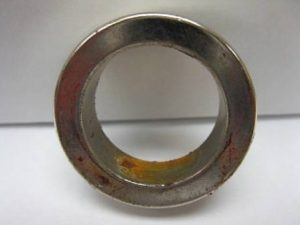Neodymium magnets have poor resistance to corrosion and can also corrode from the inside-out if proper pre-treatment processes are not followed. Often, multi-layer Nickel-Copper-Nickel plating is applied to prevent failure from corrosion, but this preventative technique may not be sufficient for all applications.
Corrosion Mechanism:
Fully dense* Neodymium Iron Boron is made with a powdered metal process. The quality of the powder dramatically impacts the resulting Neo magnet’s magnetic performance as well as environmental tolerance. Appropriately sized, well-formed powder grains with minimal un-reacted constituent elements will result in highly performing magnets. Even magnets made with ideal powder will still have some un-reacted components which will oxidize or rust. (Poorly made magnets may oxidize from the inside out.)

Typically, a corrosion preventive layer is applied in the form of a coating or plating. Because of the reactive nature of the NdFeB alloy, coating and plating adhesion is always a concern. Neo magnets are not coated or plated to a particular ASTM, ASM, etc. specification; however, the performance of a coating or plating is typically evaluated with a Salt Spray/Salt Fog Test (SST) and this is executed in accordance with ASTM B117.
The Neo alloy, magnet geometry, and corrosion inhibiting layer work in concert to extend the operational life of the magnet. Dura has compiled minimum performance characteristics of various coating and plating options for Neo magnets based on the ASTM B117 Salt Fog testing method. This method is only for evaluating Neo magnets which have a corrosion inhibiting layer.
Neodymium Magnets without coating or plating will fail immediately in the Salt Fog environment. The Salt Fog test is used to evaluate the performance of the plating or coating and it is not used to judge the quality of the Neo alloy itself. Various elevated temperature and humidity tests can be used to evaluate the bare Neo alloy. The effective volume loss of the evaluated neo magnet is used to determine the quality of the neo magnet alloy. One compares the effective mass before and after the environmental testing exposure. (The “lost” volume is portion of the Neo alloy which reacted during the environmental testing and “rusted”. The rust/oxidation is removed from the sample and the resulting mass difference between the initial state is quantified.)
It is imperative to apply the correct corrosion inhibiting layer or to encapsulate any Neo magnet used in a commercial application. (The corrosion preventative layer can be absent for proof of concepts and prototypes.)
Please engage a Dura magnet application specialist for help with determining the best method for extending the operational life of the Neodymium magnet to be used in your application.
* The “fully dense” aspect refers to the fact that the particular Neo magnet has been sintered and is not comprised of a plastic/epoxy binder. Neodymium magnets that utilize a plastic/epoxy binder are injection or compression molded. They are not fully dense and are isotropic.


ITAR Registered & Compliant
We are registered and compliant with the International Traffic in Arms Regulations (ITAR). This qualifies us to work with items listed on the United States Munitions List (USML). We are also ITAR registered with the Directorate of Defense Trade Controls (DDTC).